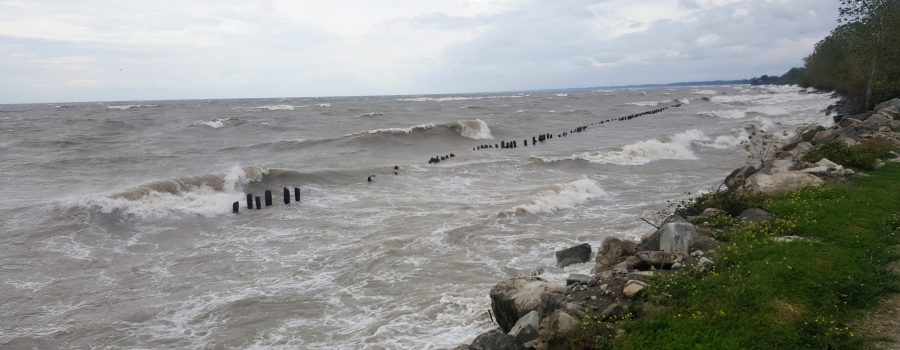Highlights:
• Current water levels on the lakes are well above average, and basically the same as they were this time last year.
• Sustained wind speeds above moderate can create waves that cause flooding, erosion, and shoreline damage.
• The risk of wave spray flooding, along the shorelines of both lakes, will continue until the lakes freezes over.
• The risk of erosion and damage to shoreline protection works on both lakes, including erosion along the high bluffs, will also continue until the lakes freeze over for the winter.
• When temperatures drop, but before the lakes freeze over, there is a risk of icy conditions in shoreline areas when wave spray and flood waters freeze.
Message:
Average daily water levels on Lake Erie at the beginning of January were around 174.70 m (I.G.L.D.). This is down about 45 cm from this year’s peak daily average water level record set at the end of May. It is also 2 cm higher than it was on January 1st, 2020. The all time record high monthly average for January was 174.86 m, set back in 1987. Water level forecasts are currently predicting Lake Erie water levels to remain basically unchanged over the month of January.
Average daily water levels on Lake St. Clair at the beginning of January were around 175.65 m (I.G.L.D.). This is down about a half metre from this year’s peak daily average water level record set during the third week of May. It is also 2 cm higher than it was on January 1st, 2020. The all time record high monthly average for January was 175.80, set back in 1986. Water level forecasts are currently Lake St. Clair could see a rise is water levels by 7 or 8 cm by the beginning of February.
Current water levels on the lakes are still well above average. While they may have dropped around a half metre from their peaks in May, they are basically at the same level they were this time last year. Therefore, the risk of flooding and other shoreline damage is very much the same as it has been over the last few years. These risks will remain until winter conditions cause the lakes to freeze over.
Strong winds out of any direction could have an impact on some areas along our local shorelines. In the most vulnerable areas, such as Erie Shore Drive in Chatham-Kent, wave spray related flooding can begin at sustained wind speeds as low as 30 km/hr, while other less vulnerable areas may need wind speeds closer to 45 km/hr. Gale force winds of 60 km/hr could be expected to cause significant flooding and shoreline damage to any low lying shoreline area. The area’s most frequently impacted communities and the relevant wind direction include: Lighthouse Cove when winds are out of a north through west direction; Erie Shore Drive when winds are out of the south (SW through SE); the bay side of Erieau when winds are out of a north through east direction; Shrewsbury when winds are out of the east (NNE through ESE); and Rose Beach Line when winds are out of a south through northeast direction. Of course, other shoreline areas are also susceptible.
Wave spray will continue to be the main cause of flooding along the LTVCA shorelines, which will still depend on the wind speed, wind direction, and the waves they create. In some low-lying shoreline areas, such as Erie Shore Drive, there may still be some waves overtopping shoreline protection works when the waves are large. Until the lakes freeze over, there will continue to be a risk of flooding. When air temperatures are below the freezing point, wave spray and flood waters could freeze onto shoreline structures, nearby homes, the ground, or even nearby roadways. In the past, this has caused cottages along Erie Shore Drive to become covered in ice, which creates even more risks to residents. Over the last couple of years, floodwaters have frequently made their way onto the roadways in Lighthouse Cove and onto Erie Shore Drive. This could create very icy and treacherous conditions for walking and travelling in shoreline areas.
Erosion and shoreline damage are still concerns as well. The same waves that cause wave spray flooding can damage shoreline protection works and cause erosion in unprotected areas. The bluff areas all along the Lake Erie shoreline are also at a greater risk of erosion due to the high lake levels, especially when there are onshore winds and waves. Along the bluffs, the erosion can cause the bluffs to fail and there have been times over the last few years when many metres of land have fallen into the lake all at one time. Such failures do not necessarily happen during a high wind and wave event and exactly when the bluff may fail is not something that can be predicted.
Please contact your local municipality should flooding and/or erosion events occur, or should events occur that could impact roadways and other public infrastructure. If there is an urgent risk to personal safety, call 911.
Shoreline residents need to pay attention to local conditions and be prepared. Most importantly, people need to keep themselves safe. Should an event occur, people should be extra careful and avoid the shoreline and any waterways with high water levels. The waves on the lakes can be strong, and the shoreline and the banks of waterways can be slippery and unstable. There could also be hazardous debris within the waves and water which could be thrown onto the shoreline. Standing water can also present unseen hazards. Children and animals should be kept away from the water.
This is a standing message issued for the month of January. Should weather forecasts suggest a sustained wind event likely to cause shoreline issues, this message will be upgraded.
Message Contact: Jason Wintermute ([email protected])

